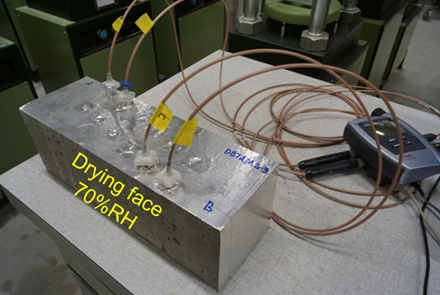Drying shrinkage
Summary
Drying shrinkage refers to the volume reduction of hardened concrete due to the loss of internal water towards the environment.
Apart from the environmental drying regime, drying shrinkage in cement based-materials is governed by the material properties development and, hence, by the microstructure development during cement hydration. For example, concrete’s drying shrinkage and its cracking susceptibility depends on several intrinsic parameters such as free shrinkage, tensile strength, stiffness, fracture toughness and creep/relaxation.
At early-age, the above-mentioned material properties, and in general the microstructural properties (such as porosity, pore size distribution and pore connectivity), are in continuous development due to the progress of cement hydration. As such, the characterization of time-dependent and moisture-dependent properties (i.e. drying shrinkage, moisture transport, or creep/relaxation) becomes difficult at early-age due to the impossibility to decouple the actual material property investigated from the ongoing hydration.
A fundamental understanding of the drying shrinkage behavior at early-age is of paramount importance for predicting the development of concrete performance and, specifically, the likelihood of cracking. Indeed, at early-age, cement-based materials are particularly prone to drying shrinkage cracking, as the material properties are still developing, such as the tensile strength.

PhD Thesis of Carmelo Di Bella
The PhD project of Carmelo Di Bella at ETH Zurich investigated the mechanisms of drying shrinkage of cementitious materials at early ages, which differentiates it from most previous studies dedicated to mature concrete. The focus on early ages brings with it the challenge of understanding and modelling the simultaneous occurrence of drying and cement hydration (with the accompanying development of moisture state, transport properties and mechanical properties), including their coupling.
The main novelty of this thesis is the application of the equivalent system approach (also called microstructurally-designed system approach or mimicked systems in the literature). This recently developed approach is based on substituting part of the cement in the mix design with a specific amount of inert filler (in this case quartz) with particle size distribution similar to that of the cement. During curing of these systems, all available cement reacts with water to form hydration products, while the unreacted quartz filler represents the unhydrated cement remaining in the microstructure at specific stages of hydration. By tailoring the amount of quartz filler in the system, different hydration stages can be represented by microstructures in which the ensemble of the hydration products and the inert filler are inert (i.e., there is no unhydrated cement ready to react), while having the same volumetric proportions as the early-age systems. With this approach, it is possible to decouple drying and shrinkage from cement hydration and microstructural changes accompanying it. The equivalent systems represent early stages of hydration in which moisture transport, shrinkage and cracking can be studied at equilibrium and all the involved material properties can be measured on unchanging systems. This allows to gather all the information that is necessary for modelling the early-age behaviour with a poromechanics approach – the second important aspect of this thesis next to the very extensive experimental section.
This thesis was funded by the Nanocem consortium, with stron support of LafargeHolcim (especially of the late Dr. Gilles Chanvillard) and Sika (Dr. Arnd Eberhardt). Part of the work was performed during an extended stay at Technical University of Denmark (DTU), under the supervision of Professor Henrik Stang.
Further publications stemming from this thesis:


-
Share
